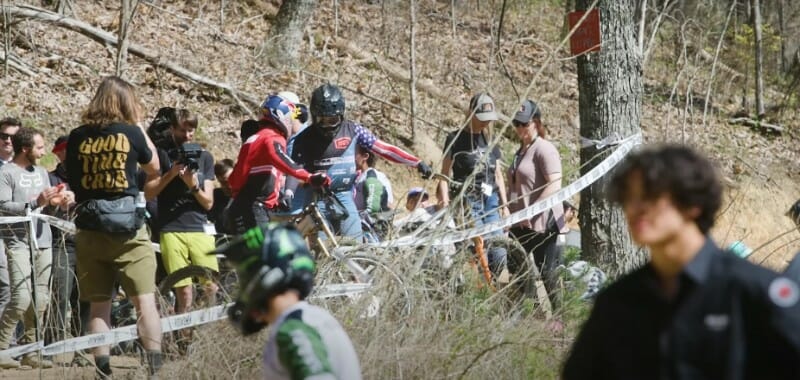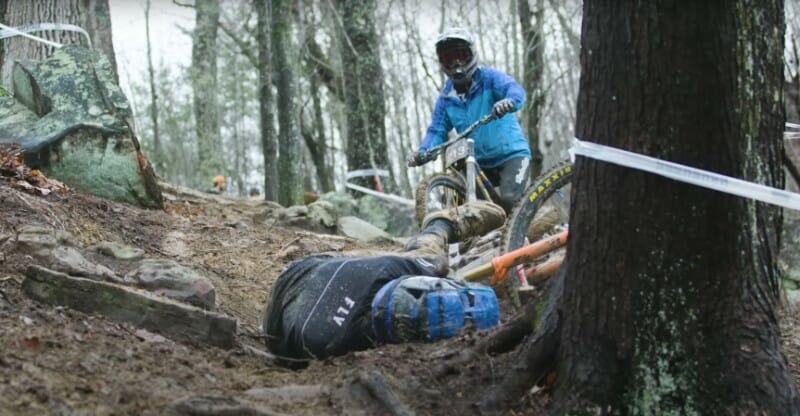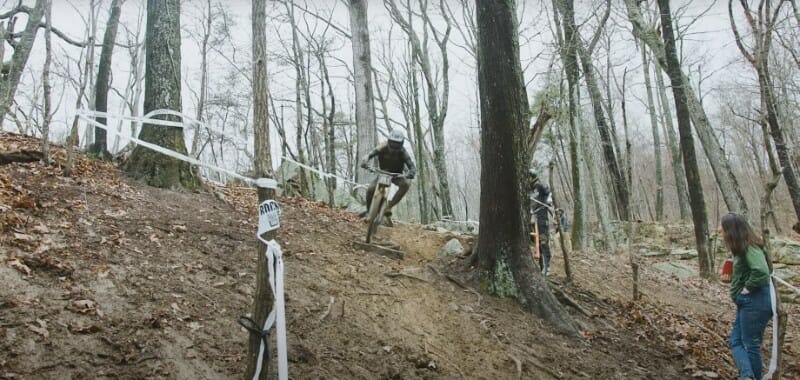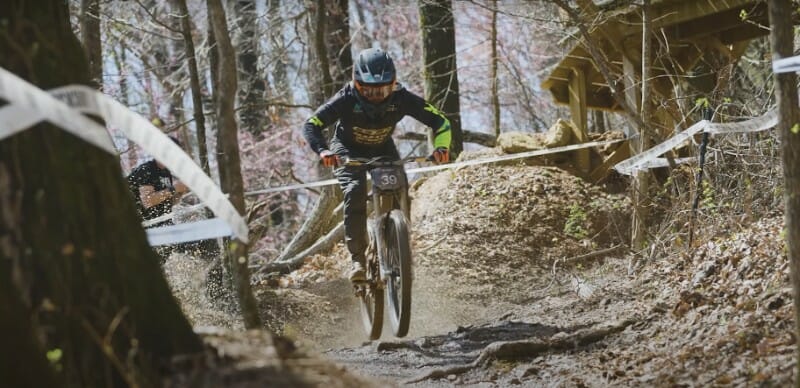8 Reasons Marshals Blow The Whistles In Downhill Mountain Bike Races

If you’ve ever watched downhill mountain biking, you may have noticed something peculiar: the course marshals are often equipped with whistles.
What could these small, seemingly insignificant objects possibly have to do with the intense sport of downhill mountain biking?
In DH mountain bike races, whistles play a crucial role in keeping everyone safe and engaged. They not only alert spectators but also help riders safely re-enter the track and locate any fallen competitors. They are also used to signal the exciting start of the race. As per the official UCI Regulations for Mountain Bike Races, track marshals dutifully blast their whistles to signal each and every rider passing by.
Here I will explain eight reasons for the use of whistles in downhill mountain biking, including their role in signaling trail conditions, communicating with other riders, and enhancing overall safety.
1. Helping Riders Safely Re-Join the Track
One of the most important responsibilities that the marshall at a race track has is to help riders re-enter the track safely.
This means they must keep an eye out for each rider as they enter and exit sections of the track, preventing any collisions from happening.
This unspoken rule amongst racers creates an efficient and safe environment in which riders can practice their lines without fear of interference from other competitors.
The whistle also serves the important role of keeping racers aware of their surroundings when entering and exiting corners during practice runs.
Riders need time between drops to survey both their line choices and what other competitors are doing, giving them time to slow down or even stop if necessary to avoid crashing into another rider on the course.
The marshall will sound a warning when a rider is about to drop in, alerting those below that someone is coming so that they can free up extra space if necessary.
2. Alerting Spectators
Downhill mountain bike racing is a thrilling sport, but safety is paramount for both riders and spectators. That’s where course marshals come in.
These guardians of the track use whistles to alert the crowd when racers are approaching, ensuring everyone stays out of harm’s way.

They also stand watch at designated crossings, allowing spectators to pass through safely.
With the sheer speed, challenging terrain, and dense vegetation, it’s crucial for course marshals to act as the first line of defense against potential dangers.
Racetracks should be marked off to minimize contact between riders and outsiders, while certain sections should remain completely unimpeded for the utmost safety.
Course marshals remind fans to stay behind their designated zones, ensuring the well-being of everyone involved. With these measures in place, everyone can experience the excitement of the race with peace of mind.
3. Finding Riders During Accidents
Mountain biking accidents are inevitable. But quick and efficient locating of crashed riders is crucial.
When riders are on the track, marshals play a vital role in quickly and reliably finding any crashed riders.
They are strategically positioned around the track, within sight and earshot of each other, ready to observe and assist when necessary.
In the unfortunate event of a crash or a missing rider, the marshals rely on their whistles to initiate a search and find the injured or missing individual.

By blowing their whistles, the marshals attract the attention of other marshals and the medical team, swiftly indicating the severity of the accident and providing vital information about the rider’s location and condition.
This instant communication allows them to determine the general location of a missing rider if they pass one marshal but not the next.
Competitions have strict protocols for crashes, with marshals swiftly running their sections and raising flags to signal an accident.
First response personnel then take charge of emergency procedures, ensuring the removal of debris from the trackside to prevent further injuries from flying objects.
If necessary, medical personnel arrive equipped with the means to reach injured riders wherever they may be.
Finding crashed riders may seem straightforward, but it requires prompt information-sharing among marshals and efficient mobilization.
4. Part of the Flag Safety System
In official racing, having a flag safety system is crucial.
Each marshal is equipped with color-coded flags that indicate the level of danger on the track.
Yellow flags signal caution after a crash, prompting riders to slow down and use caution in the upcoming section. Red flags, accompanied by a marshal coordinator, halt riders due to emergencies.
Marshals carrying red flags must maintain visual contact with their nearby colleagues for effective communication.
Whistles are also used to signal specific situations like a rider clearing the track or requiring assistance.
5. Indicating Rider Entry From Behind
When you’re riding your bike and focused on going as fast as possible without making any mistakes, it’s really challenging to hear other bikes approaching from behind, especially if they’re just as quiet as yours.
However, you can’t miss the loud whistles that go off right behind you.
Riding on the track can be a chaotic experience, with riders having to account for each other’s performance and the unknown conditions of the environment.

To tackle this, most events follow a staggered start order based on everyone’s performance. Though, there are some caveats even with that rule in place.
Crashes, mechanical issues, and outright slower riders at times can still get caught from behind by faster ones. During practice runs, the situation is even more unpredictable since everybody is figuring out their lines and getting used to the terrain.
This makes it impossible for mountain bike riders to use rear-view mirrors like those on motocross bikes, adding an extra challenge for them to stay aware of fellow racers approaching from behind.
6. Timing Purposes
Race organizers arrange timed training sessions where riders can practice and enhance their skills on the course. During these sessions, whistles are used to indicate when a rider passes specific stages or points in the race.
For accurate recording and measurement of each rider’s time, timing transponders are attached to their bike or body. These transponders communicate with timing mats or sensors placed at different points on the course.

However, to ensure precise synchronization of the start and end of each rider’s run, whistles are used alongside the timing system.
A loud blast signifies the start of the training session, allowing riders to activate their transponders as they cross the start line.
Another blast marks the finish line, prompting riders to stop their transponders as they cross it.
Whistles provide a clear and distinct signal that can be easily heard amidst noise or challenging terrain, ensuring fair and precise timing in downhill mountain biking.
7. Signal to Start The Race
When starting pistols or lights are unavailable or not functioning, a whistle serves as a reliable backup option.
Using a whistle allows race organizers to maintain race integrity and provide a level playing field for all competitors. Having a manual whistle for this purpose is essential as it does not rely on external factors like batteries or mechanical mechanisms.
It is a dependable and cost-effective alternative that race officials can carry at all times.
The sharp and distinctive sound of a whistle also cuts through the ambient noise, capturing the attention of all riders simultaneously and prompting an immediate start.
8. Tradition from Other Cycling Disciplines
Whistles have been a longstanding tradition in cycling events, particularly in track cycling.
Coaches use them to communicate important instructions to their riders during races, while spectators use them to pump up the riders and add excitement to the event.
This signaling system quickly spread to other cycling disciplines, including downhill mountain biking, where whistles are now used to signal the start and finish of each rider’s run.
This tradition highlights how different cycling disciplines can influence and shape the sport as a whole, while also enhancing communication and fan engagement.
Final Thoughts
In downhill mountain biking races, riders don’t usually use whistles themselves. Instead, course marshals use whistles to alert spectators and competitors about an approaching rider.
The main purpose of these whistles is to ensure the safety of everyone involved.
Riders communicate with each other through body language, line choice, visual cues, and timing transponders.
These non-verbal methods allow for quick and efficient information exchange without the need for spoken words, which can be challenging during fast-paced races. Stay safe and enjoy the thrill of the ride!
Interested in learning more about mountain biking? Check out our 18 practical mountain biking tips to ride like a boss.





